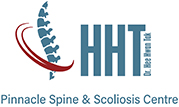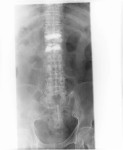Minimally Invasive Spine Surgery
With the advancing technology, key-hole minimally invasive spine surgery is now possible for a vast number of causes of your back pain. Depending on the condition of your health, your specialist may offer you these options after considering the cause of your back pain and the surgery contemplated.
Nucleoplasty
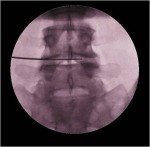
This is a minimally invasive spine surgery approach (Figure 13) to remove the jelly-fluid within the intervertebral disc to reduce the popping out (herniation), thereby relieving the compression.
This is suitable for a herniated disc that is moderate in size, and you have failed conservative non-surgical back treatment.
Foraminotomy/Laminotomy
A planned surgery in a well examined and investigated case ought to have good long term results. This means that there should be a correctable factor involved in causing your back pain, then only the operation may be successful.
The simplest operation that can be done in cases of compressed nerves is to relieve the compression by creating a hole to widen the space available for nerve roots. This can be done by removing some bone at the exit window where the nerve roots exit the spinal canal or can be done at the lamina (bony part of the spine that forms the back boundary of the column). This procedure can be done along with discectomy (removal of disc fragments that are causing the compression).
These procedures may be done as minimally invasive spine surgery.
Laminectomy
Some cases may require a wide release of compression, where the whole lamina is removed either on one side (hemilaminectomy) or both sides (total laminectomy) so as to free up the nerves and spinal cord.
These procedures may be done in a minimally invasive fashion.
Stabilization

Fractures, infection, or inflammation may cause your spine to become unstable, putting your nerves at risks. These instances may require your doctor to stabilize the spine by using various implants like pedicle screws and rods (Figure 14).
Stabilization may also be required in cases where decompression surgery is liable to cause instability after the operation.
Stabilization may be performed as a minimally invasive spine surgery nowadays.
Vertebroplasty/Kyphoplasty
These procedures involve an injection of cement into the fractured vertebra, often in cases of severe osteoporosis where the healing ability of the fractured bone is limited, and you are suffering a tremendous amount of pain. The difference between vertebroplasty and kyphoplasty is that kyphoplasty involves placing a deflated balloon, and then inflating it before cement is introduced.
These procedures are done via puncture holes and you will be under sedation throughout the procedure (Figure 15).
Interspinous Spacers
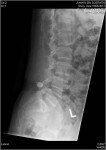
These are the implants put in between your spinous processes (beak-like projections over the back of the spine bone) to maintain the decompression, by keeping your ligaments tense and preventing it from reducing the canal space. It also restricts your back extension (backward bending movement of your spine), which indirectly prevents the spinal canal from getting narrowed down with movement.
Unlike fusion, Interspinous spacers are dynamic stabilizers. They do not restrict the movement of your spinal segment while stabilizing the space available for nerves and preventing it from causing compression over your nerves.
Insertion of such spacers may be performed via a minimally invasive approach (Figure 16) nowadays.
Fusion
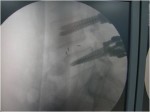
Conditions of an unstable spine, as found in infections, inflammatory causes, fractures, or wear and tear of parts of your back (spondylosis, spondylolisthesis) may require joining of the bones together to make them more stable, and prevent further damage to your back. Your specialist may advise this option after evaluating your symptoms and studying your investigations.
Fusion may be performed via a minimally invasive approach nowadays (Figure 17).
Corrective Osteotomies
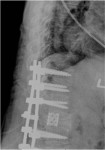
Your spinal column is specially designed for its weight-bearing and protective function. Deformities of the spine may jeopardize both of these functions and may require corrective re-alignment of the bones (osteotomy).
Osteotomy (Figure 18) is a major surgical approach and may involve significant blood loss. Before undergoing such a procedure, your health needs to be assessed carefully. Pre-surgery nutrition needs to be optimal, and blood will be taken to check your blood type in case transfusion is required.
Anterior Spine Surgeries
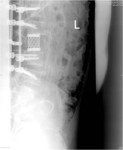
With improving implant armamentarium available to your specialists now, approaching your back from the front has become less often done, and is currently limited to a number of conditions only.
These surgeries (Figure 19) are used to remove your unhealthy bone from the front (corpectomy or vertebrectomy), or release stiff segments while correcting deformities of your back.
Non-Invasive/Operative Spinal Injections
Invasive options are always to be kept as the last resort. In cases not improving even after a considerable period of non-operative pain management, these options may be useful. But in certain conditions, it is advisable not to delay operation as delaying may reduce the success of your operation. Your specialist may tell you about the options available after an examination.
Spinal injections may help reduce the action of chemicals causing your nerve to get irritated or angry (inflammation). They can be injected through various sites depending on the nerves affected. It can be either injected from your back near the particular nerve root (trans-foraminal nerve root block) or injected from near the tail-bone (caudal epidural injections). In certain conditions like wear and tear of joints in your back, specially targeted blocks may be given into the joints (facet blocks). You may feel relieved of pain immediately because of the local anaesthetics. The spinal injection may also cause your legs to go numb for some time. It may carry some risks too, like dizziness or headaches. So, it is advisable for you to bring somebody along to get you back home after your nerve injection.
Multiple injections at intervals may be required to give you long-term pain relief. But because of the adverse effects, your doctor may restrict the number of injections you may take per year. These injections may also be required to localize the pain area of your back.
Learn more about the Symptoms of Back Pain, Causes of Back Pain, Back Pain Diagnosis and Non-surgical Treatment. For a comprehensive consultation to decide which treatment is best suited for your health, contact our spine specialist Dr Hee Hwan Tak today.
Some patients may experience back pain problems as their body degenerates, Dr Hee’s patient was featured on the news.
